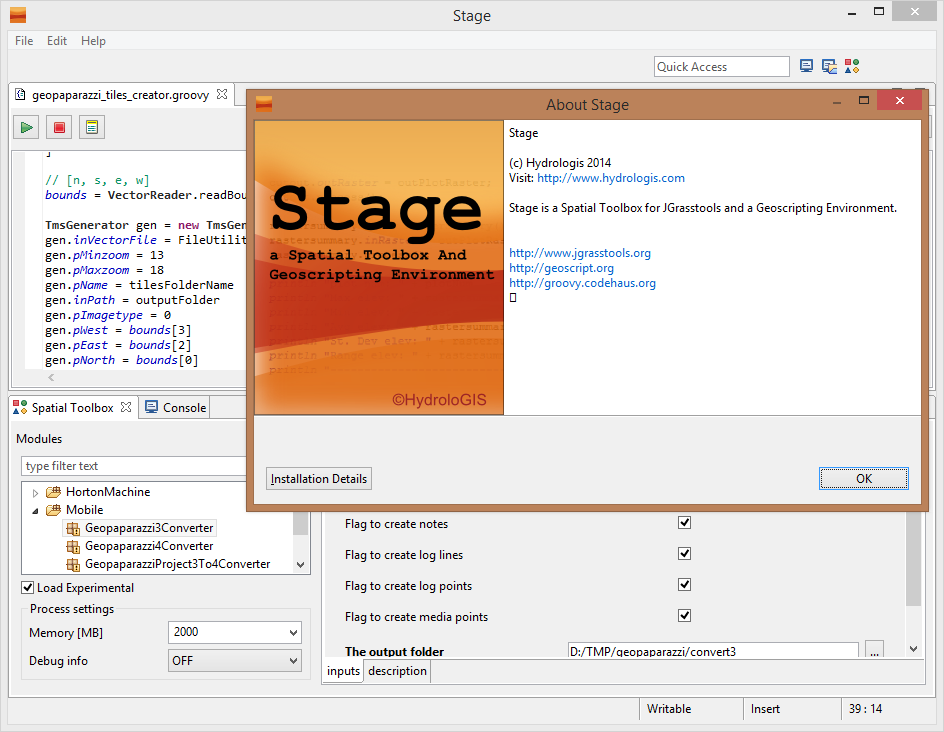Well well, jumping from 3.9.0 to 3.9.3.
Not that there haven't been news in the last two releases:
version 3.9.2 (released 2014-02-06)
Fix for two nasty bugs:
- TMS tile map source not working
- form text resets on rotation
version 3.9.1 (released 2014-02-03)
- language updates
- fix for gpx export time bug
- fix for image notes problem
- fix zoom "jumping"
- fix for spatialite info tool
- several enhancements
But well, time is what it is :)
Let's get to the point of this point: version 3.9.3!
Version 3.9.3 brings a couple of nice enhancements, so I will take some time to describe them properly:
1) Labels for spatialite layers
From the layers view it is now possible to access a labels button (second from left):
to select some simple properties for labels:
This will result in something like (thanks Mark for the screenshot):
Labeling at this time is very simple. No collision detection and labels on lines suffer of steep angles. Also labels in polygons are placed in the baricenter of the polygon, so for strange shapes (or multi-shapes), the label might lie outside the geometry.
But it is a good and very useful start.
2) WMS mapurls TANTO service
Together with the friends from the
geospatial blog TANTO and in particular
Giovanni, after having seen all the problems that the creation of a mapurl for WMS services was causing, we decided to create a small service, that would automatically generate mapurls for geopaparazzi for known services.
For geopaparazzi users everything is transparent, the import view has a new entry: MAPURL
Once you enter that menu, you find the services query view:
Here you can define some filter parameters and start the query.
In my case I had the gps placed in Italy, so the query returned me:
One can then simply download the service, which will install the mapurl inside your system. The user is prompted for a custom name to name the service after, else the original name will be used. Since the original name could be duplicated in different services, the prefix "tanto_" will be added in that case.
This service is in a very experimental state right now, but it works fairly well. If you experience problems, please report them at the link right here below.
Also to auggest WMS services you would like to see inside geopaparazzi, please follow the link below and read how this can be done.
3) GPX fixes
GPX data are now imported also with the name and dsecription in it.
4) OSM and GMAP urls are better supported
While geosms is still well supported, I had the need to add some message to it that could be nicely tapped on and create a bookmark. The real problem here is that urls do not allow spaces, so something like:
http://maps.google.com/maps?q=45.40658400,10.90924600&GeoSMS place to link
when tapped in the sms app, would not include the "place to link" in the url.
It is now possible to add after a last dash some information without spaces:
http://maps.google.com/maps?q=45.40658400,10.90924600#placeToLink
or
http://www.openstreetmap.org/#map=19/46.68124/11.13489&layers=N#placeToLink
The above will both result in a new bookmark in geopap with the text: placeToLink
5) new icons
All the icons have bee redone with the
Android Asset Studio resulting in very smooth icons on all device I tested them on.
Well well, I wish I had more time to dress this as a 1st April joke as many do, but I think I am just boring today. And if the app doesn't appear on google play, it is just because google play is slow in releasing :)
Enjoy!


















